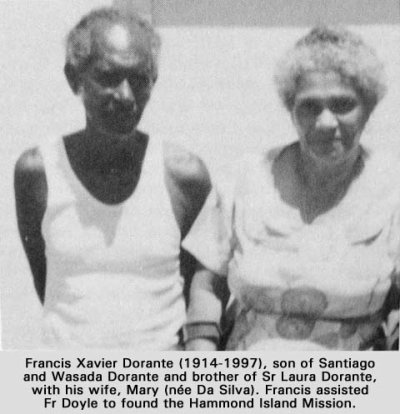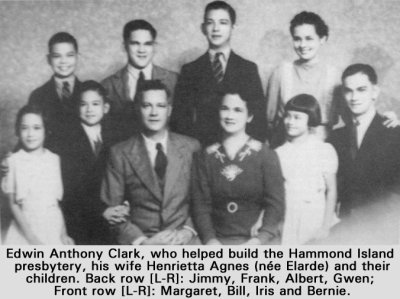KASAMA Vol. 23 No. 2 / April-May-June 2009 / Solidarity Philippines Australia Network
Pre-war Filipino communities in Torres Strait
Thursday and Horn Islands
 Kasama readers are aware of the first wave of Filipino migration to Australia in the late 19th century, when hundreds of seamen sought employment in the pearlfields of northern Australia. Filipino crews moved between Broome, Darwin and Thursday Island, establishing links that endure to this day and enriching the local Indigenous societies through their religion, music, cuisine and language. In Torres Strait, the men established the largest Filipino communities of northern Australia on Thursday Island and neighbouring Horn Island.
Kasama readers are aware of the first wave of Filipino migration to Australia in the late 19th century, when hundreds of seamen sought employment in the pearlfields of northern Australia. Filipino crews moved between Broome, Darwin and Thursday Island, establishing links that endure to this day and enriching the local Indigenous societies through their religion, music, cuisine and language. In Torres Strait, the men established the largest Filipino communities of northern Australia on Thursday Island and neighbouring Horn Island.
From 1870, the year that commercial quantities of pearlshell were first taken from the strait, Filipinos were brought in to dive for shell and gather bêche–de–mer for higher wages than at home. Missionary Fr Ferdinand Hartzer wrote of his arrival on Thursday Island in 1884: ‘we found the place populated by a small number of Europeans and about 400 Catholics from Manila scattered amongst the various islands. They were there fishing for pearls.’ The majority were young, single men from Manila, Cebu, Leyte, Luzon, Masbate, Panay and Samar. Most of them settled on Thursday or Horn Island, sometimes after living for a time on the outer islands: Juan Blanco and Joseph Kanak on Erub (Darnley Island); Santiago Dorante on Edgor (Nepean Island); Johnny Francis on Auridh (Skull Island); Nicholas Sabatino on Erub, Tudu (Warrior Island) and Yam Island.
In 1901, 253 Filipinos were employed in the Torres Strait marine industry but, as the Japanese came to dominate the industry, most Filipinos went elsewhere. The Australian pearling industry was in decline, whereas the Philippines industry was being developed under American control. The Immigration Restriction Act of 1901 further diminished the number of Asian settlers in Australia.
 Most of the Filipinos who were naturalised, had families, owned businesses and property, or had lived many years in Australia, remained on cosmopolitan, crowded Thursday Island, the commercial and government centre. Among them were the Alcala, Alipio, Angeles, Assacruz, Canendo, Canuto, Castor, Conanan, Delacruz, Dorante, Elarde, Gallardo, Garcia, Garr, Guivarra, Irlandes, Lasica, Lohado, Lopez, Perez, Reyes, Rodriguez, Sabatino, Spain, Surla, Tolentino, Vilamera and Zarcal families.
Most of the Filipinos who were naturalised, had families, owned businesses and property, or had lived many years in Australia, remained on cosmopolitan, crowded Thursday Island, the commercial and government centre. Among them were the Alcala, Alipio, Angeles, Assacruz, Canendo, Canuto, Castor, Conanan, Delacruz, Dorante, Elarde, Gallardo, Garcia, Garr, Guivarra, Irlandes, Lasica, Lohado, Lopez, Perez, Reyes, Rodriguez, Sabatino, Spain, Surla, Tolentino, Vilamera and Zarcal families.
Horn Island, directly south, attracted those choosing a more Filipino–centric communal life, among them the Blanco, Bullio, Castro, Fabian, Galora, Lloren, MacBire, Manantan, Mayor, Pelayo, Raymond, Remedio and Sim families. The first settler on Horn Island in c.1888, Pedro Galora, was soon joined by Raphael Louis Castro, Gregorio Leon Fabian (or Pavian), Pablo Remedio and Ramon Roas and their locally–born Indigenous wives.
The community grew steadily to about 150 in 1895, after which there was a gradual decline to 42 in 1903, followed by an increase to 73 in 1906. Almost 70 births were recorded between 1889 and 1932, the year before the opening of the new Catholic Church, built by the residents and ‘nestled away under the cocoanut trees’, with a bamboo floor, cocoanut thatch walls and an iron roof.
 Members of both communities were evacuated to mainland Australia in 1942 and few returned. Nevertheless, the Tagalog words which have entered Torres Strait Creole and dishes like dinaguan [the Filipino dinuguan], thought to be traditionally Islander, demonstrate their influence on Torres Strait Islander custom. Marriage, adoption, shared experiences and friendships link Filipino-descended families with hundreds of other northern Australian families. In Torres Strait several thousand descendants of those early settlers, while proud of their Filipino heritage, identify primarily as Torres Strait Islanders, the second group of indigenous Australians.
Members of both communities were evacuated to mainland Australia in 1942 and few returned. Nevertheless, the Tagalog words which have entered Torres Strait Creole and dishes like dinaguan [the Filipino dinuguan], thought to be traditionally Islander, demonstrate their influence on Torres Strait Islander custom. Marriage, adoption, shared experiences and friendships link Filipino-descended families with hundreds of other northern Australian families. In Torres Strait several thousand descendants of those early settlers, while proud of their Filipino heritage, identify primarily as Torres Strait Islanders, the second group of indigenous Australians.
Hammond Island
The Catholic church played a significant role in the life of the early Filipinos in Torres Strait, Broome and Darwin. The immigrants and their families became the core and mainstay of the fledging Catholic community on Thursday Island from 1884: they assiduously attended religious services, contributed to parochial finances, captained and manned the mission boats, and built the presbytery, church, hospital, convent and school. In return, the church gave religious, moral, educational, medical and financial support to the men and their families.
 Almost every marriage recorded between Filipino men and local Indigenous women was celebrated in the Thursday Island church, the wives converting to Catholicism. There was often a considerable age difference between husband and wife, so that from the turn of the century the brides were themselves almost all the daughters of Filipino seamen. Large families were the norm and the children were raised and educated as Catholics.
Almost every marriage recorded between Filipino men and local Indigenous women was celebrated in the Thursday Island church, the wives converting to Catholicism. There was often a considerable age difference between husband and wife, so that from the turn of the century the brides were themselves almost all the daughters of Filipino seamen. Large families were the norm and the children were raised and educated as Catholics.
During the interwar period, when ‘racial purity’ became a dominant ideology of the Anglo-Germanic-Nordic peoples, children born to parents of different ‘races’ were called ‘half-castes’ and strongly disapproved of. Sexual relations between Islanders and non-Islanders were proscribed and official permission had to be obtained for marriage. Nevertheless, the increasing number of children born to local women by Asian, Pacific Islander or European men was an embarrassment for the authorities. The Church had always assumed responsibility for the Catholics among them and in 1928 it obtained permission to establish a settlement for Filipino-headed families on neighbouring Hammond Island (Keriri).
 The island was officially inaugurated as St Joseph’s Catholic mission station on Ascension Thursday 1929, administered jointly by the Missionaries of the Sacred Heart Order and the Queensland government, and with a population of exclusively Filipino descent. The families of Nicholas Sabatino from Iloilo and Joseph Kanak from Guam were the first to settle there. Their wives, Joanna Lojado Sabatino and Raphaela Garcia Kanak, were the daughters of Filipino divers. In 1930 the first marriage took place between Felicia Jack and Antonio Dorante, the locally–born son of Santiago Dorante from Samar. Antonio’s sister, Laura, entered the newly established Papuan Order of the Handmaids of Our Lord in 1915, and was followed by Sisters Theodora Canuto, Celestine Blanco, Julianna McBire and Mary Patrice Sabatino, all born on Thursday Island to Filipino fathers.
The island was officially inaugurated as St Joseph’s Catholic mission station on Ascension Thursday 1929, administered jointly by the Missionaries of the Sacred Heart Order and the Queensland government, and with a population of exclusively Filipino descent. The families of Nicholas Sabatino from Iloilo and Joseph Kanak from Guam were the first to settle there. Their wives, Joanna Lojado Sabatino and Raphaela Garcia Kanak, were the daughters of Filipino divers. In 1930 the first marriage took place between Felicia Jack and Antonio Dorante, the locally–born son of Santiago Dorante from Samar. Antonio’s sister, Laura, entered the newly established Papuan Order of the Handmaids of Our Lord in 1915, and was followed by Sisters Theodora Canuto, Celestine Blanco, Julianna McBire and Mary Patrice Sabatino, all born on Thursday Island to Filipino fathers.
Catholic families were encouraged to move from other islands to the mission, especially after a school was opened in 1935 (until then the children had attended the convent school on Thursday Island). By 1937, 130 people, a third of them schoolchildren, were permanent residents and, as mission inhabitants, they were exempted from the onerous provisions of the
Aboriginals Acts. In 1942 the mission inhabitants were evacuated to the Cooyar on the mainland and the mission buildings taken over by the army.
The Sabatino and Dorante families were the first to return but many remained behind. Other families arrived from the islands to rebuild. In 1964 the priest and sisters moved to Thursday Island and the children travelled there for school; in 1984 there were 174 people and 30 homes. Today, no longer a mission but a conventional Torres Strait community, Hammond Island Community has almost entirely lost its pre–war Filipino character.

 About The Author:
About The Author:
Dr Anna Shnukal has authored over sixty publications on Torres Strait language, education and history, and has lived and worked in almost all of the island communities since early 1981. She is the primary editor of
Navigating Boundaries: The Asian Diaspora in Torres Strait.
Photos: Our First 100 Years, Sacred Heart Mission, Thursday Island 1884-1984, Centenary Celebrations Committee, 1984.
Further Reading:
Navigating Boundaries: The Asian Diaspora in Torres Strait, Anna Shnukal, Guy Ramsay & Yuriko Nagata (eds.), Canberra: Pandanus Books, 2004.
Woven Histories Dancing Lives: Torres Strait Islander Identity, Culture and History, Richard Davis (ed.), Canberra: Aboriginal Studies Press, 2004.





 About The Author:
About The Author:  Home | Aims and Objectives of Solidarity Philippines Australia Network | About Kasama
Home | Aims and Objectives of Solidarity Philippines Australia Network | About Kasama 